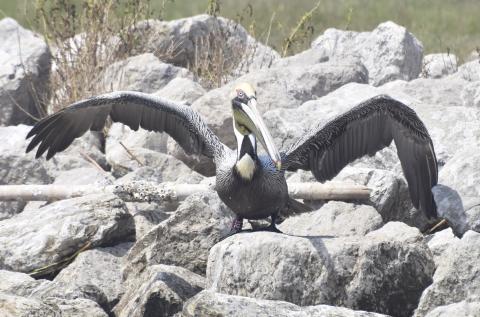Brown pelicans were severely impacted during the 2010 Deepwater Horizon oil spill. A massive rescue effort took place immediately following the spill. As a result, yet another of the 582 rescued and rehabilitated pelicans has made its way back to the Louisiana coast in a wonderful display of resiliency.
In the summer of 2020, we shared good news about pelican“A04” -- named after the tracking tag placed on its leg – which had returned to a newly restored Queen Bess Island. Now, less than a year after that sighting, we have more good news of a resident returning home.
In June 2010, pelican “Red 33Z” was rescued from Barataria Bay, the area of the Gulf of Mexico that experienced the worst impacts of the Deepwater Horizon oil spill. When rescued, the pelican was triaged at a local facility and then transported for full rehabilitation elsewhere in Louisiana.
Red 33Z’s home was still considered an impact zone from the oil spill, and to prevent further injury, rescued wildlife cannot be returned where they were found if conditions are still unsafe. So, once the pelican was able to travel, it was taken to the U.S. Coast Guard station in Brunswick, Georgia, and released in July.
Brunswick, Georgia is about 700 miles in a straight shot from Red 33Z’s home in Louisiana, but that didn’t stop it from making the return journey. This year, Red 33Z found a Queen Bess Island that has 30 more acres of pelican nesting habitat than the one it left behind.
In an April 2021 news release, Louisiana Department of Wildlife and Fisheries Non-game Ornithologist Robert Dobbs stated, “brown pelicans, like most seabirds, are thought to be hard-wired, genetically, to return to their birth colony to breed, despite moving long distances during the non-breeding season.”
The damage to birds from the oil spill was widespread. The Trustees have estimated that more than 100,000 birds across 93 species were killed by the spill.
Therefore, restoration efforts have been underway on the Louisiana coast to bring back the habitat vital to brown pelicans and other colonial nesting waterbirds. Through comprehensive restoration planning and project implementation, the Louisiana Trustee Implementation Group has focused on restoring an interconnected group of barrier islands, including Queen Bess Island, North Breton Island, Rabbit Island and Isle au Pitre. Recently, the Louisiana Trustees have called for project ideas for activities focused on restoring Wetlands, Coastal, and Nearshore habitats, which will likely have indirect benefits for birds.
The Louisiana Trustee Implementation Group will continue to provide updates on projects and restoration plan approvals that benefit birds. In the meantime, welcome home to Red 33Z!


